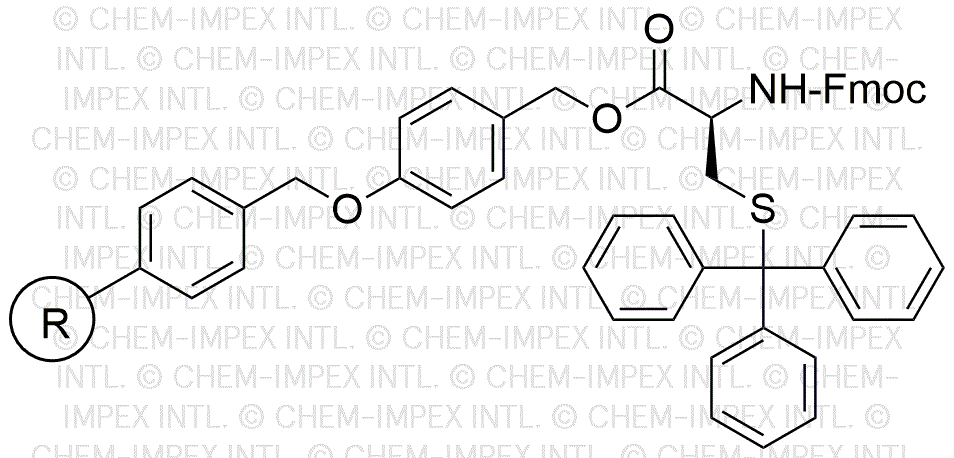Fmoc-S-trityl-L-cysteine 4-alkoxybenzyl alcohol is widely utilized in research focused on:
- Peptide Synthesis: This compound serves as a protecting group in the synthesis of peptides, allowing for selective functionalization of amino acids without unwanted reactions.
- Drug Development: It plays a crucial role in the design of novel pharmaceuticals, particularly in creating compounds that target specific biological pathways.
- Bioconjugation: The chemical is used to attach biomolecules to surfaces or other molecules, enhancing the development of biosensors and targeted drug delivery systems.
- Research in Cancer Therapeutics: Its unique properties allow researchers to explore new treatments by modifying existing compounds to improve efficacy and reduce side effects.
- Material Science: The compound is applied in the development of advanced materials, such as coatings and polymers, that require specific chemical functionalities for enhanced performance.
Informations générales
Propriétés
Sécurité et réglementation
Applications
Fmoc-S-trityl-L-cysteine 4-alkoxybenzyl alcohol is widely utilized in research focused on:
- Peptide Synthesis: This compound serves as a protecting group in the synthesis of peptides, allowing for selective functionalization of amino acids without unwanted reactions.
- Drug Development: It plays a crucial role in the design of novel pharmaceuticals, particularly in creating compounds that target specific biological pathways.
- Bioconjugation: The chemical is used to attach biomolecules to surfaces or other molecules, enhancing the development of biosensors and targeted drug delivery systems.
- Research in Cancer Therapeutics: Its unique properties allow researchers to explore new treatments by modifying existing compounds to improve efficacy and reduce side effects.
- Material Science: The compound is applied in the development of advanced materials, such as coatings and polymers, that require specific chemical functionalities for enhanced performance.
Documents
Fiches de données de sécurité (FDS)
La FDS fournit des informations de sécurité complètes sur la manipulation, le stockage et l’élimination du produit.
Spécifications du produit (PS)
Le PS fournit une description complète des propriétés du produit, notamment sa composition chimique, son état physique, sa pureté et les exigences de stockage. Il détaille également les plages de qualité acceptables et les applications prévues du produit.
Certificats d'analyse (COA)
Recherchez des certificats d'analyse (COA) en saisissant le numéro de lot du produit. Les numéros de lot et de lot se trouvent sur l'étiquette d'un produit, après les mots « Lot » ou « Lot de fabrication ».
Numéro de catalogue
Numéro de lot/série
Certificats d'origine (COO)
Ce certificat d'exploitation confirme le pays dans lequel le produit a été fabriqué, et détaille également les matériaux et composants utilisés et s'il est issu de sources naturelles, synthétiques ou autres sources spécifiques. Ce certificat peut être requis pour les douanes, le commerce et la conformité réglementaire.
Numéro de catalogue
Numéro de lot/série
Fiches de données de sécurité (FDS)
La FDS fournit des informations de sécurité complètes sur la manipulation, le stockage et l’élimination du produit.
DownloadSpécifications du produit (PS)
Le PS fournit une description complète des propriétés du produit, notamment sa composition chimique, son état physique, sa pureté et les exigences de stockage. Il détaille également les plages de qualité acceptables et les applications prévues du produit.
DownloadCertificats d'analyse (COA)
Recherchez des certificats d'analyse (COA) en saisissant le numéro de lot du produit. Les numéros de lot et de lot se trouvent sur l'étiquette d'un produit, après les mots « Lot » ou « Lot de fabrication ».
Numéro de catalogue
Numéro de lot/série
Certificats d'origine (COO)
Ce certificat d'exploitation confirme le pays dans lequel le produit a été fabriqué, et détaille également les matériaux et composants utilisés et s'il est issu de sources naturelles, synthétiques ou autres sources spécifiques. Ce certificat peut être requis pour les douanes, le commerce et la conformité réglementaire.


